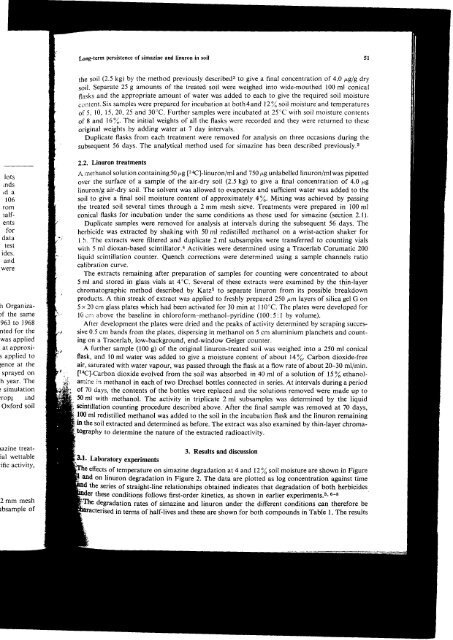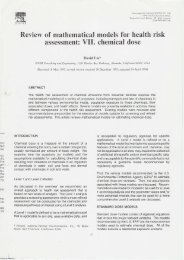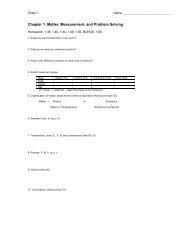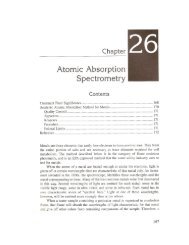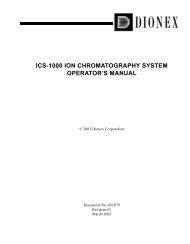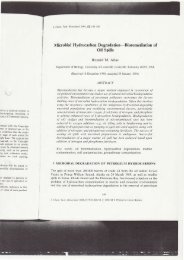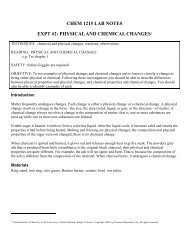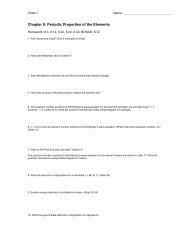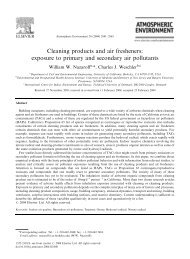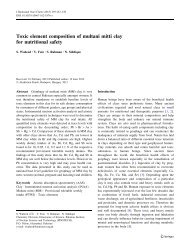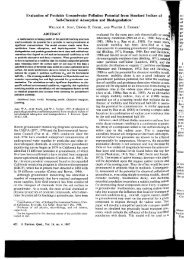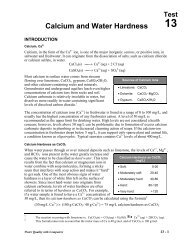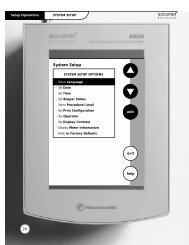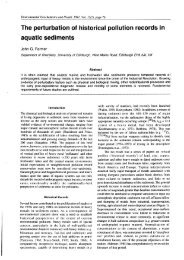Simulation of Herbicide Persistence in Soil
Simulation of Herbicide Persistence in Soil
Simulation of Herbicide Persistence in Soil
- No tags were found...
Create successful ePaper yourself
Turn your PDF publications into a flip-book with our unique Google optimized e-Paper software.
Long-term persistence <strong>of</strong> simaz<strong>in</strong>e and l<strong>in</strong>uron <strong>in</strong> soilthe soil (2.5 kg) by the method previously described3 to give a f<strong>in</strong>al concentration <strong>of</strong> 4.0 pglg drysoil. Separate 25 g amounts <strong>of</strong> the treated soil were weighed <strong>in</strong>to wide-mouthed 100 ml conicalflasks and the appropriate amount <strong>of</strong> water was added to each to give the required soil moistureccntent. Six samples were prepared for <strong>in</strong>cubation at both 4 and 121 soll moisture and temperatures<strong>of</strong> 5, 10. 15,20,25 and 30'C. Further samples were <strong>in</strong>cubated at 25'C with soil moisture contents<strong>of</strong> 8 and 16)1. The <strong>in</strong>itial weights <strong>of</strong> all the flasks were recorded and they were returned to theseorig<strong>in</strong>al weights by add<strong>in</strong>g water at 7 day <strong>in</strong>tervals.Duplicate flasks from each treatment were removed for analysis on three occasions dur<strong>in</strong>g thesubsequent 56 days. The analytical method used for simaz<strong>in</strong>e has been described previously.3lotsrndsrda106romralfentsfordatatestides.andwereh Organizarfthe same963 to I 968nted for thewas appliedat approxisapplied totence at thesprayed onh year. The: simulation:ropl rndOxford soil2,2. L<strong>in</strong>ur on treatmentsA rnethanol solution conta<strong>in</strong><strong>in</strong>g50 pg IaC]-l<strong>in</strong>uron/ml and 750 pg unlabelled l<strong>in</strong>uronimlwas pipettedover the surface <strong>of</strong> a sample <strong>of</strong> the air-dry soil (2.5 kg) to give a f<strong>in</strong>al concentration <strong>of</strong> 4.0 pgl<strong>in</strong>uron/g air-dry soil. The solvent was allowed to evaporate and sufficient water was added to thesoil to give a flnal soil moisture content <strong>of</strong> approximately 4'%. Mix<strong>in</strong>g was achieved by pass<strong>in</strong>gthe treated soil several times through a 2 mm mesh sieve. Treatments were prepared <strong>in</strong> 100 mlconical flasks for <strong>in</strong>cubation under the same conditions as those used for simaz<strong>in</strong>e (section 2.1).Duplicate samples were removed for analysis at <strong>in</strong>tervals dur<strong>in</strong>g the subsequent 56 days. Theherbicide was extracted by shak<strong>in</strong>g with 50 ml redistilled methanol on a wrist-action shaker forI h. The extracts were filtered and duplicate 2 ml subsamples were transferred to count<strong>in</strong>g vialswith 5 ml dioxan-based sc<strong>in</strong>tillator.a Activities were determ<strong>in</strong>ed us<strong>in</strong>g a Tracerlab Corumatic 200liquid sc<strong>in</strong>tillation counter. Quench corrections were determ<strong>in</strong>ed us<strong>in</strong>g a sample channels ratiocalibration curve.The extracts rema<strong>in</strong><strong>in</strong>g after preparation <strong>of</strong> samples for count<strong>in</strong>g were concentrated to about5 ml and stored <strong>in</strong> glass vials at 4'C. Several <strong>of</strong> these extracts were exam<strong>in</strong>ed by the th<strong>in</strong>-layerchromatographic method described by Katzs to separate l<strong>in</strong>uron from its possible breakdownproducts. A th<strong>in</strong> streak <strong>of</strong> extract was applied to freshly prepared 250 pm layers <strong>of</strong> silica gel G on5 x 20 cm glass plates which had been activated for 30 m<strong>in</strong> at I10"C. The plates were developed forl0 cnr above the basel<strong>in</strong>e <strong>in</strong> chlor<strong>of</strong>orm-methanol-pyrid<strong>in</strong>e (100:5: I by volume).After development the plates were dried and the peaks <strong>of</strong> activity determ<strong>in</strong>ed by scrap<strong>in</strong>g successive0.5 cnr bands from the plates, dispers<strong>in</strong>g <strong>in</strong> methanol on 5 cnr alum<strong>in</strong>ium planchets and count<strong>in</strong>gon a Tracerlab, low-background, end-w<strong>in</strong>dow Geiger counter.A further sample (100 g) <strong>of</strong> the orig<strong>in</strong>al l<strong>in</strong>uron-treated soil was weighed <strong>in</strong>to a 250 ml conicalflask, and l0ml water was added to give a moisture content <strong>of</strong> about 141. Carbon


